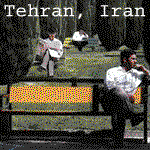Guantánamo Detainees Stage Hunger Strike
 By TIM GOLDEN
By TIM GOLDENPublished: April 9, 2007
A long-term hunger strike has broken out at the American detention center at Guantánamo Bay, Cuba, with more than a dozen prisoners subjecting themselves to daily force-feeding to protest their treatment, military officials and lawyers for the detainees say.
Lawyers for several hunger strikers said their clients’ actions were driven by harsh conditions in a new maximum security complex. About 160 of the roughly 385 Guantánamo detainees have been moved to the complex since December.
Thirteen detainees are now on hunger strikes, the largest number to endure the force-feeding regimen on an extended basis since early 2006, when the military broke a long-running strike with a new policy of strapping prisoners into restraint chairs while they are fed by plastic tubes inserted through their nostrils.
The hunger strikers are now monitored so closely that they have virtually no chance to starve themselves. Yet their persistence underscores how the struggle between detainees and guards at Guantánamo has continued even as the military has tightened its control in the past year.
“We don’t have any rights here, even after your Supreme Court said we had rights,” one hunger striker, Majid al-Joudi, told a military doctor, according to medical records released recently under a federal court order. “If the policy does not change, you will see a big increase in fasting.”
A military spokesman at Guantánamo, Cmdr. Robert Durand of the Navy, played down the significance of the current strike, calling the prisoners’ complaints “propaganda.”
But the protests come as criticism of Guantánamo continues to rise in the United States and abroad. Last week, after the Supreme Court denied a new appeal on behalf of the detainees, the head of the International Committee of the Red Cross delivered a rare public reprimand to the Bush administration, saying the prisoners’ ability to contest their detention was inadequate.
Newly released Pentagon documents show that during earlier hunger strikes, before the use of the restraint chairs, some detainees lost more than 30 pounds in a matter of weeks. By comparison, the current hunger strike — in which 12 of the 13 detainees were being force-fed as of Friday — seems almost symbolic.
For instance, the medical records for Mr. Joudi, a 36-year-old Saudi, showed that when he was hospitalized on Feb. 10, he had been fasting for 31 days and had lost more than 15 percent of his body weight.
By the time he was transferred a few days later to a “feeding block” where more serious hunger strikers are segregated from other prisoners, his condition had stabilized and his weight was nearly back to an ideal level for a man his size. (His exact weight gain was not recorded.) Mr. Joudi was subsequently flown home and turned over to the Saudi authorities, his lawyer said.
Lawyers for several detainees held in the new maximum security complex, known as Camp 6, compared it to “supermax” prisons in the United States. The major differences, they said, are that the detainees have limited reading material and no television, and only 10 of the Guantánamo prisoners have been charged.
The Camp 6 inmates are generally locked in their 8-foot-by-10-foot cells for at least 22 hours a day, emerging only to exercise in small wire cages and to shower. Besides those times, they can talk with other prisoners only by shouting through food slots in the steel doors of their cells.
“My wish is to die,” one reported hunger striker in the camp, Adnan Farhan Abdullatif, a 27-year old Yemeni, told his lawyer on Feb. 27, according to recently declassified notes of the meeting. “We are living in a dying situation.”
Commander Durand, the Guantánamo spokesman, dismissed such accounts as part of an effort by the prisoners and their lawyers to discredit the detention mission. He described the new unit as much more comfortable than the detainees’ previous quarters, and denied that they suffered any greater sense of isolation in the new cell blocks.
“This was designed to improve living conditions,” Commander Durand said, “and we think it has.”
Camp 6 was originally designed as a modern, medium-security prison complex for up to 200 inmates, with common areas where they could gather for meals and a large fenced athletic field where they could jog or play soccer outside the high concrete walls.
But after a riot last May and the suicides of three prisoners in June, the unit was retrofitted before opening to limit the detainees’ freedom and reduce the risk that they might hurt themselves or attack guards, military officials said.
As Camp 6 was opening, senior officials expressed concern about how prisoners would react to its greater isolation. Most had been held in makeshift blocks of wire-mesh cells that — while often hot, noisy and lacking privacy — allowed them to communicate easily, pray together and even pass written messages.
Guantánamo’s other maximum-security unit, Camp 5, has cells that face each other across a short hallway, allowing the roughly 100 detainees there to converse fairly easily. In Camp 6, the prisoners can see one another from their cells only when one of them is being moved. At other times, they look out on the stainless-steel picnic tables in the common areas they are not allowed to use.
Lawyers for several Camp 6 detainees said their clients were despondent about the move even though, as military officials note, the new cells are 27 square feet larger than the old ones and have air-conditioning, nicer toilets and sinks, and a small desk anchored to the wall.
“They’re just sitting on a powder keg down there,” said one lawyer, Sabin Willett, who, like others, described growing desperation among the prisoners. “You’re going to have an insane asylum.”
Lawyers who visited Guantánamo recently said the detainees reported a higher number of hunger strikers than had the military — perhaps 40 or more. Military officials said there were sometimes “stealth hunger strikers,” who pretend to eat or surreptitiously vomit after eating, but they dismissed the detainees’ estimates as exaggerations.
Because reporters are prevented from speaking with detainees or visiting most of their cell blocks, it is difficult to verify the conflicting accounts.
Hunger strikes have been part of life at Guantánamo almost since the detention center opened in January 2002.
They reached a peak in September 2005, when more than 130 detainees were classified as hunger strikers, having refused at least nine consecutive meals, military records show. As the strikes went on, some detainees being force-fed continued to lose weight by vomiting or siphoning their stomachs with the feeding tubes. But by early February 2006, shortly after the military began using restraint chairs during the forced feedings, the number of hunger strikers plunged to three.
The number rose again sharply but briefly last May, reaching 86 after three detainees attempted suicide and a riot broke out as the guards searched for contraband. Yet even then, no more than seven strikers were forced into the restraint chair regimen.
Three detainees who had been hunger strikers hung themselves on June 10. After July, no more than three detainees subjected themselves to extended forced feeding.
That number began to grow again as detainees were moved into Camp 6 in December. By mid-March, the number of hunger strikers reached 17. For the first time, as many as 15 detainees continued with the strikes despite being force-fed in the restraint chairs.
Military officials have described the restraint chair regimen as unpleasant but necessary. They originally said prisoners needed to be restrained while digesting, so they could not purge what they were fed.
Now, the rationale has changed. The restraints are generally applied “for safety of the detainee and medical staff,” records show, and they are kept on for as little as 15 minutes at a time, rather than the two hours commonly used before. Afterward, the prisoners are moved to a “dry cell” and monitored to make sure they do not vomit.
Even so, some detainees describe the experience as painful, even gruesome.
One Sudanese detainee, Sami al-Hajj, a 38-year-old former cameraman for Al Jazeera, described feeling at one point that he could not bear the tube for another instant. “I said I would begin to scream unless they took it out,” he wrote in a recent diary entry given to his lawyer.
“They finally did.”
Stephen H. Oleskey, who represents Saber Lahmar, an Algerian religious scholar whom military officials accused of propagating a religious legal ruling that was linked to the suicides, said of his client: “The man has been in segregation — virtual isolation — for over nine months. Physically and emotionally, he’s collapsing. We think this punishment does exceed what the law allows, and that he won’t survive.”
Military officials said Mr. Lahmar and other detainees had received adequate medical attention.
Labels: Guantanamo Bay, Guantánamo Bay














2 Comments:
They should eat something.
blazing cat fur,
Guantánamo should be shut down, it is against international law.
Post a Comment
<< Home